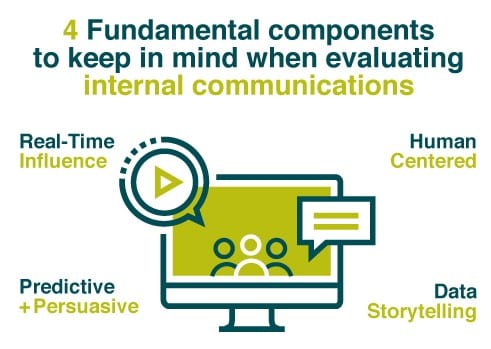 Advances in technology have made today’s employee more accessible than ever before. Facebook, Slack, Twitter, Snapchat—the biggest tech platforms in the world are all centered around communication and enabling organizations to connect internally in new ways. However, the impact of technology on internal communications has just as many disadvantages as benefits.
Advances in technology have made today’s employee more accessible than ever before. Facebook, Slack, Twitter, Snapchat—the biggest tech platforms in the world are all centered around communication and enabling organizations to connect internally in new ways. However, the impact of technology on internal communications has just as many disadvantages as benefits.
The traditional cascade communications model, where organizations send messages from the top down, is bordering on the archaic as today’s employees often find themselves inundated with messages from across an organization—making them harder to reach. Compound that with the ability to filter through messaging more easily and employee engagement is suffering. To combat this, organizations must not only re-evaluate their approach to communications, but also how the impact is measured.
Organizations must first get into a mindset where measurement is critical, and develop and deploy the tools and technology to monitor the channels in place to reach employees. By analyzing findings and identifying opportunities to improve communications, organizations can begin to make data-fueled decisions about the cadence, audiences and proper channels for strategic messaging.
Measurement comes in many forms, but the key to determining what works for an organization, from website analytics to comments on internal stories, is an analysis of the messaging’s tone. Many consultancies and tools exist out there to help with this but, in the meantime, here are the four fundamental questions we recommend leaders ask themselves when evaluating communications (click to tweet):
- Where is the impact of the communications in real-time?
More and more organizations set up Social Media Command Centers for teams to monitor, listen and draw insights from data and conversations in real time. Determining how to do the same type of real-time listening to employees is rapidly becoming a reality.
- Is the communication human-centered?
You’ll often find truly happy customers are actually talking to truly empowered employees. Eurostar’s contact center handles an average of 16,500 calls and 3,000 emails every week. To ensure its service agents can spend less time on administration, and more time enriching customer experiences, Eurostar uses Service Cloud by Salesforce. Specifically, they use Salesforce Chatter, the enterprise social networking tool, to simplify information sharing and accelerate responses.
- How predicative and persuasive are your messages?
We helped one of the Big 4 public accounting firms determine which internal communications messages, messengers and channels would lead to higher effectiveness so we could increase employee engagement firm-wide. Ask yourself, “Is this resonating with employees?”
- Is data being expressed through engaging and visual stories?
In her Persuasion and the Power of Story video, Stanford University Professor of Marketing Jennifer L. Aaker explains that stories are meaningful when they are memorable, impactful and personal. In our work with a medical device company, we created visual representations of the personas of employees, the information that was most important to them, the barriers they faced in getting information, and the channels they used most frequently. Creating visual stories helped connect leaders and communicators to the data in an emotional way.
What’s your approach to measuring communication that matters most to employees?


